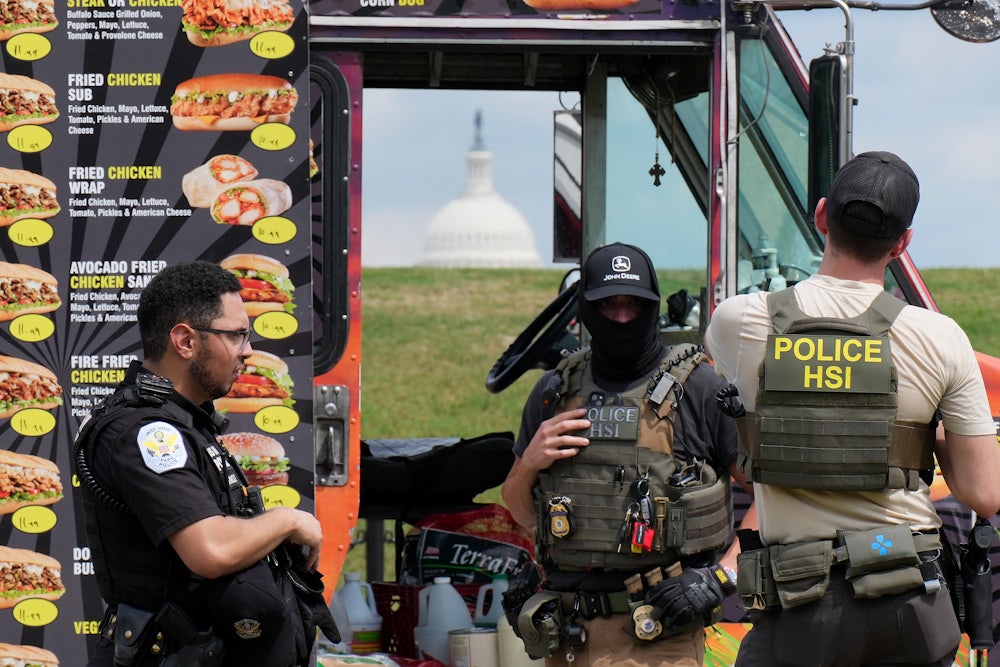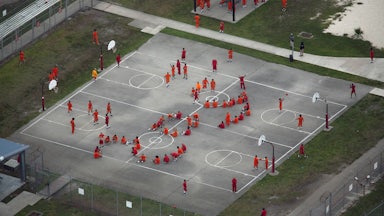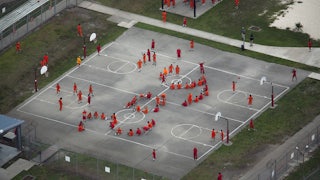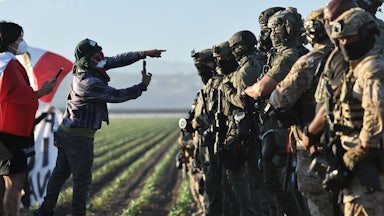As it begins building the largest law enforcement agency in the country, the Department of Homeland Security has lately turned to social media to recruit immigration enforcement officers. These posts have been characterized as “mean memes,” or as another sign of the Trump regime’s penchant for “kitsch,” but one particularly egregious example posted Monday shows quite clearly how meanness and kitsch are ideal vehicles for neo-Nazi messaging. “Which way, American man?” the @DHSgov account on X posted, along with an AI-sloppy cartoon of Uncle Sam considering competing road signs: “Cultural Decline,” “Homeland,” “Invasion,” “Opportunity.” It’s a message meant to help the agency with its “rapid recruitment” of 14,050 new immigration enforcement agents, as decreed by Trump (and with new funding from Congress). The phrase is a nod to the 1978 book Which Way, Western Man?, a foundational text for white nationalists. The book’s most accessible edition was published by the neo-Nazi press National Vanguard Books, which was founded by William Luther Pierce III, the author of the racist dystopian novel The Turner Diaries. Elements of The Turner Diaries’ fascist climax, “the Day of the Rope,” made their way into the far-right imaginary, and into the shape of the Capitol insurrection on January 6, 2021.
This was hardly the first time DHS drew on such tropes. At Religion Dispatches, Annika Brockschmidt and Thomas Lecaque, both experts on the far right, likened the agency’s recent posts to “firehosing the internet with white supremacist propaganda.” A July 28 post tells “EVERY CRIMINAL ILLEGAL IN AMERICA” that they “represent an existential threat to the citizens of the United States.” It follows the announcement with an unsettling, melodramatic video of men in tactical gear, cradling their weapons in slow motion, with an aesthetic that recalls 2022’s The Batman. (The video even appropriated a bleak monologue from the film as its voiceover.) Five days earlier came a message that was almost camp in its execution: “A Heritage to be proud of, a Homeland worth Defending,” the post reads, illustrated by a painting—John Gast’s American Progress, from 1872—featuring a sunny, milk-fed, blond giant leading settlers in covered wagons as they chase off a group of Indigenous people, rendered under shadowy storm clouds. Worse, the caption DHS provided appeared to nod to a neo-Nazi slogan, “We must secure the existence of our people and a future for white children.” When asked about the post by Zeteo writer Prem Thakker, DHS spokesperson Tricia McLaughlin replied, “This administration is unapologetically proud of American history and American heritage. Get used to it.” Indeed, DHS has previously promoted itself with other paintings linking its operations to American manifest destiny and small-town Americana.
Seeing a federal agency openly circulate racist and antisemitic propaganda as intentionally “edgy” content is disturbing enough. But such a recruitment drive is also coming from an agency that is (or was, under previous administrations) tasked with keeping tabs on white nationalist groups. What this latest propaganda wave from DHS reveals, in part, is an agency that has been weaponized for the Trump administration’s political purposes. But DHS didn’t reluctantly acquiesce to that weaponization, as has sometimes been presumed. Instead, it eagerly assimilated MAGA’s mass deportation mission, adopted its language, and became its standard-bearer online. The shift is, unfortunately, not so shocking, given the agency’s history. From its very origins, DHS has repeatedly downplayed the threat of white nationalism while focusing its law enforcement power on groups—Muslims, immigrants, left-wing activists—it deemed a threat to an imaginary version of the ideal America.
A skeptic might suggest that DHS simply doesn’t know what its posts are invoking. But DHS ought to be familiar with such tropes—and, especially, with The Turner Diaries and the neo-Nazi and white nationalist groups it has influenced. The text was reportedly one inspiration for the 1995 bombing of an Oklahoma City federal building, which was carried out by a white nationalist. In the past, the agency tracked “domestic violent extremism” and acknowledged that such groups’ ability to recruit and mobilize online was “potentially making extremist individuals and groups more dangerous and the consequences of their violence more severe.” This was the finding of a DHS analyst’s 2009 paper, which DHS subsequently repudiated before disbanding the team behind it. “DHS is scoffing at the mission of doing domestic counterterrorism, as is Congress,” the paper’s author, Daryl Johnson, told Spencer Ackerman at Wired in 2012. Johnson observed that although there had been numerous white supremacist attacks over the previous few years, there were no hearings about the rising white supremacist threat—“but,” he pointed out, “they still hold hearings about Muslim extremism.”
That’s really what the Department of Homeland Security, under which Immigration and Customs Enforcement operates, was built for. It is a product of the American “global war on terror,” as well as one of its engines. Back in October 2001, Nation columnist Patricia J. Williams, a professor of law and philosophy at Northeastern University, noted that already “the word ‘homeland’ has burrowed its way into ordinary conversation and multiplied with astonishing rapidity.” From the start, “homeland” sounded exclusionary and bombastic. “I wonder about the line-drawing such an odd term was calculated to evoke,” Williams wrote. “Like the Bush team’s attempt to sound epic? Like some effort to denationalize and fuse enemy status with that of domestic criminality?”
We are doubling back around the same circular path, where agencies such as DHS downplay white nationalist violence, both potential and actual, while they draw recruits from those same ranks. We have been here before. Recall the attack on Charlottesville, Virginia, in 2017. “Unite the Right was billed, accurately, as the largest gathering of the far-right in recent memory,” wrote Shane Burley, author of Fascism Today, “a full-force showing of a thousand white nationalists.” The Department of Homeland Security’s Office of Intelligence and Analysis issued a bulletin on Unite the Right three days before the rally, which it called a “free speech event.”
The DHS bulletin was very concerned about the presence of “anarchist extremists” at the rally. “We assess that anarchist extremists’ use of violence as a means to oppose racism and white supremacist extremists’ preparation to counterattack anarchist extremists are the principal drivers of violence at recent white supremacist rallies,” the bulletin stated. That is, DHS intelligence analysts saw anarchists as the primary aggressors and white supremacists as merely engaged in “preparation to counterattack.” Michael Gould-Wartofsky, an ethnographer of fascism, saw for himself, on the streets in Charlottesville on August 12, 2017, the results of such an assessment: “Law enforcement acted accordingly, with the more than 1,000 officers on the scene opting to stand back and stand by (as Trump would instruct the Proud Boys to do on live TV in 2020)—until it was too late.” A man who had marched that day with the white nationalist group Vanguard America soon after deliberately drove his car through a group of anti-racist demonstrators who had gathered on the streets in opposition, injuring two dozen people and killing one: Heather Heyer.
This week, DHS spokesperson Tricia McLaughlin tried to dismiss Wired’s reporting on the dehumanizing and sometimes white nationalist meme posts as “a silly little story.” When the White House responded, it did so in the memes’ own vernacular, with spokeswoman Abigail Jackson declaring that the administration “won’t apologize for posting banger memes.”
The message behind this ICE recruitment drive is so casually cruel that it seems like there must be more to it than just some guys got hired at DHS to riff on ideas from white nationalist accounts. What if DHS is acting like this because this is DHS, and to a certain extent, it has been primed for exactly this job? If the masked agents snatching people off the street didn’t do it, DHS’s unhinged posts should make clear how proud our government is of brutalizing and dehumanizing people, so proud it has to tell us constantly throughout the day that it’s doing it all for us—and don’t you want to join?










